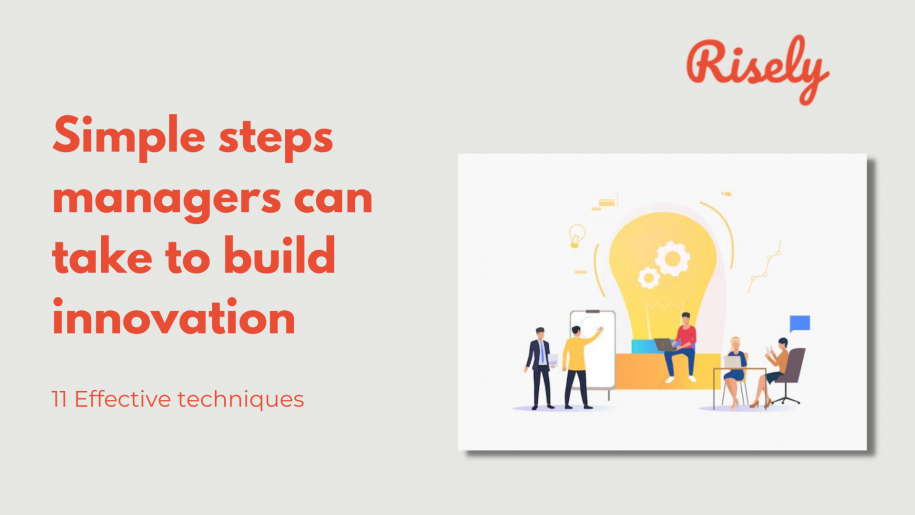11 simple steps managers can take to build innovation
For any globally successful business, innovation has been the key. The top brands of today’s world, say Google or Apple, are built on it that delivers unmatched value to their customers. It has become pivotal to success, so every manager wants to build innovation in their team. Consequently, the question of how to build innovative teams keeps troubling team managers. Building innovative teams is not as easy as enforcing a new set of rules. Enabling a creative process requires many intrinsic nuts and bolts to move, which are not easily visible to a manager. Yet, innovation remains crucial for any business due to multiple reasons. Primarily, every organization wants success, which usually looks like a more significant market share. It is essential as it provides a much-needed differentiating factor from your competitors that can be your competitive edge. It also helps you remain relevant even as the market changes rapidly. Companies that innovate their products continuously to suit new developments can retain their consumers even in the face of change. In an environment where there’s always something new coming up, even the employees will remain engaged. Therefore, managers must undertake building innovative teams as a managerial responsibility. You can take some actions as a manager to stimulate innovation building in your team.5 Reasons Why Innovation is the Engine of a Thriving Workplace
The world is constantly evolving, and so should your workplace. Here’s why innovation is no longer a luxury but a necessity for any business that wants to stay ahead of the curve:- Standing Out From the Crowd: It fosters the creation of new products, services, or processes that differentiate you from competitors. Imagine a world where every bank offered the same savings accounts and mobile apps. Innovativeness lets you break the mold, attract new customers, and solidify your brand as a leader in the industry.
- Adapting to Change: The business landscape is constantly shifting, with new technologies, consumer trends, and regulations emerging all the time. Companies that embrace creativity develop the agility to adapt to these changes. Think of Blockbuster clinging to brick-and-mortar rentals while Netflix revolutionized movie streaming. Innovation allows you to anticipate change and be the disruptor, not the disruption.
- Employee Engagement and Morale: Who wants to work in a stagnant environment? Innovation injects a sense of excitement and purpose into the workplace. Employees feel valued when their ideas are heard and encouraged. This fosters a culture of creativity, collaboration, and problem-solving, leading to a more engaged and motivated workforce.
- Boosting Efficiency and Productivity: It isn’t just about flashy new products. It’s also about streamlining processes and finding smarter ways to get things done. This can involve automating tasks, implementing new technologies, or simply rethinking traditional workflows. It helps you maximize your resources and productivity.
- Attracting Top Talent: The best and brightest minds are drawn to companies with a reputation for creativity. They want to be part of something exciting and have the opportunity to make a real impact. By fostering a culture of creativity, you position yourself as a magnet for top talent, giving your business a significant competitive edge.
How to build innovation in your team?
1. Create a conducive environment
Before planting, one must prepare the soil. Similarly, to build innovation, you must prepare the environment first. Unfortunately, the familiar environment in many organizations is adverse to change. As a manager, you first must ensure that the attitude towards change is welcoming. Therefore, an environment where new thoughts are promoted rather than discouraged is essential. An open mindset that is looking for progress is central to this.2. Create an innovation development framework
In the next step, the manager can focus on developing a framework to facilitate innovation. Such systems can be embedded in the organization’s structure itself. For instance, managers can ease the movement toward the project’s development stage when an employee proposes an innovation. In addition, a ready system to handle such ideas comes handy in trying out new ideas without delay.3. Hire for the purpose
People usually prefer to keep their tasks limited to their defined roles. Yet, managers look for people who go beyond the basics and put new ideas on the table. To combat this mismatch, try to hire people who take an active interest in what your organization does and have a knack for experimentation. Ideas are more likely to come up when people are personally engrossed in their actions.4. Incentivize innovation
Employees would be more eager to think outside the box if they earn benefits from it. People are more likely to develop innovations when they have personal attachments to their work. Moreover, the system works better if its progress is tied to the organization’s progress. Personal incentives work great in creating loyalty toward the organization. Recognition boosts morale and encourages other employees to develop something new too.5. Encourage new ideas
It is of utmost importance for the manager to encourage experimentation among their employees. A culture of creatovity is based on the freedom to try and fail repeatedly. To cultivate this culture, give a chance to new ideas – listen and deliberate instead of offering outright rejections. Then, adopt those ideas and reward successes to encourage more innovation.Other Interesting Reads
6. Empower the employees
After encouraging them to develop ideas, provide empowerment that allows people to work on them. For example, you may allow employees to have some time to work on their innovations solely. You can also provide support by easily making the tools and people required to make the innovation available. While doing so, trust your employees and their decision-making ability. People who are deemed responsible and accountable contribute more effectively to the organization.7. Reduce hurdles
Innovation building happens the best in a free-flowing environment. But unfortunately, many organizations suffer from bureaucratic lethargy and red-tapism, wherein every single action requires the consent of many unwilling and uninvolved people. Therefore, reducing the problems one faces while bringing out something new is essential. So time and effort are spent working on ideas instead of overcoming hurdles.8. Reduce stress
The absence of confidence can also strangle innovation development. Some brilliant employees may lack the ability to express their ideas effectively. Managers can work to improve the self-esteem of their employees and provide avenues to share. Managers must also ensure that their employees are not ostracized for suggesting change. Innovations are more likely to come up when people are secure regarding their job and social perception.9. Change leadership styles
Innovation can begin right from you! Understand your leadership and management style before moving on to innovation for your product offering. Identify structural issues that prevent creativity and solve them through these interventions. A change in managerial style gives a new orientation to the organization’s thoughts. These changes facilitate organization-wide innovation and reduce the usual hurdles that prevent it. Know more: Finding the leadership style that works for you!10. Learn to accept failures
While promoting innovations, realizing you won’t consistently achieve success is essential. Many attempts will fail, and you might even have to suffer losses. But it is vital to recognize these as a part of the journey and not take failures to your heart. Instead, turn these failures into learning opportunities. Managers should encourage their employees even after they have failed previously. They have to ensure that failure is not the end of the story. Rather, turn it into an avenue for employee development.11. Let the creativity flow
Most importantly, there can be no stoppages to the flow of creativity if innovative ideas are what you are aiming for. Innovation takes root in creative minds that are ready to solve problems. The solutions to them may not appear clearly and well-structured in the beginning. The process of refining and redesigning has to go on to create something unique for the world from an creativity. Even popular revolutionary products, like the internet or computer technology, have undergone many changes. Innovations are a continuous quest for the better.Conclusion
The key takeaway here is that innovation is vital to success. Therefore, a manager must take steps to build innovative teams in their organization. These actions can be at various levels. They can either change the manufacturing process or overhaul the management style itself. Small steps that make the atmosphere more welcoming for change and creativity are also necessary! Although there is no clearly defined pathway towards a creative milestone, the actions described above can surely be your catalyst.Build a growth mindset in your team to encourage innovation and creativity!
Download the free growth mindset toolkit to achieve the growth you aspire for.
Other Related Blogs
Informal Learning: All You Need To Know
In this blog, we’ll look at why informal learning matters for the growth of your team and provide actionable insights on how you, as a leader, can encourage and cultivate…
What are the Top 10 Good Trainer Characteristics?
In this blog, we’ll explore the top 10 good trainer characteristics that define a successful facilitator and learn some practical tips for becoming a good trainer. … Read More
Empower Your Workforce: 13 Training and Development Programs For Employees
In this blog, we explore thirteen training and development programs for employees and the key benefits of investing in your employees’ growth, including boosting productivity, enhancing job satisfaction, and reducing…
5 Secrets To Ace Project Manager Training
5 Secrets To Ace Project Manager Training You’ve poured your heart and soul into building a dream team. You’ve recruited talented individuals with diverse skill sets, and you’re confident they…


